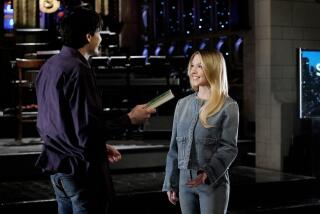L.A. architect wins battle at Gettysburg
For more than a decade, Los Angeles architect Dion Neutra has waged a personal battle to save his family’s controversial legacy on the Gettysburg battlefield.
Half a century ago, he worked alongside his world-famous father, architect Richard Neutra, on the Cyclorama Center, designed to house a massive circular painting depicting Pickett’s charge.
In 1999, the National Park Service announced its intention to move the painting and tear down the building -- which sits in the middle of the battle line where Union troops defended Cemetery Ridge -- to restore the landscape to its 1863 appearance.
The decision touched off a long battle between Civil War purists and modern-architecture preservationists that may have finally reached its conclusion.
U.S. District Judge Thomas F. Hogan in Washington sided with the modernists. In a ruling last week, he wrote that the park service had failed to comply with federal law requiring it to analyze the effect of the Cyclorama Center demolition and come up with alternatives to destroying it.
Dion Neutra, now 83, who along with the group Recent Past Preservation Network sued to save the building, hopes the park service takes the opportunity to reconsider.
“Narrowly speaking, the park could jump through some hoops and tear the building down, but we hope they revisit the idea of reusing it,” he said.
“We’re very pleased,” said Matthew Adams, whose firm, Sonnenschein Nath & Rosenthal, represented the Recent Past Preservation Network. “Our goal is not just to obstruct the process, but to look at ways to protect the battlefield and protect the building.”
Neither Gettysburg park officials nor the park service would comment on the decision.
Park officials have said they consider the 20th-century building an incursion on the historic site of Pickett’s charge, where Union forces held back a Confederate assault on the third day of the battle.
Last year, the park tore down the original visitor center and parking lot next to the Cyclorama Center, and it planned to demolish the building as part of its effort to restore the 1860s-era Ziegler’s Grove.
Andrew Ames, a spokesman for the Justice Department, said the agency was reviewing the decision.
“No determination has been made as to the government’s next step in this matter,” Ames said.
The federal court ruling may signal a turning point in the movement to save modernist landmarks, which supporters argue are as worthy of preservation as older, more traditionally designed structures.
The Cyclorama Center, which opened in 1962, was part of a federal effort begun under President Eisenhower to build visitor facilities at national parks. The timing of its construction coincided with the Civil War centennial.
“It has great architectural significance,” said Jason Hart, a Boston architect, whose firm has come up with an array of design possibilities to save all or part of the building. Hart said it was meant as a monument to President Lincoln, who delivered the Gettysburg Address a few hundred yards away, at the national cemetery.
“There are those who say it doesn’t have anything to do with Gettysburg, but the opposite is true,” Hart said. “It has a lot of meaning and value to Gettysburg.”
Neutra said the Cyclorama Center was “way up” on his father’s list of the most important buildings of his career. The elder Neutra began working in the United States in the 1920s and died in 1970.
Architectural luminaries such as Frank Gehry and Robert A.M. Stern have agreed, sending letters of support to save the center.
Dion Neutra has watched the building deteriorate since the painting was removed for restoration in 2006. Now, he wants to be a part of its rebirth -- “if they’d hire us again.”
He said he recently discovered that his father had had a broader vision for the museum than simply to house the painting.
“He wanted to commemorate the Gettysburg Address, as opposed to just commemorating the battle,” he said. “The idea was for a monument to address the notion of reconciliation as Lincoln had tried to do in the Gettysburg Address. We could do that in a dynamic way today.”
Worden writes for the Philadelphia Inquirer.
More to Read
The biggest entertainment stories
Get our big stories about Hollywood, film, television, music, arts, culture and more right in your inbox as soon as they publish.
You may occasionally receive promotional content from the Los Angeles Times.






